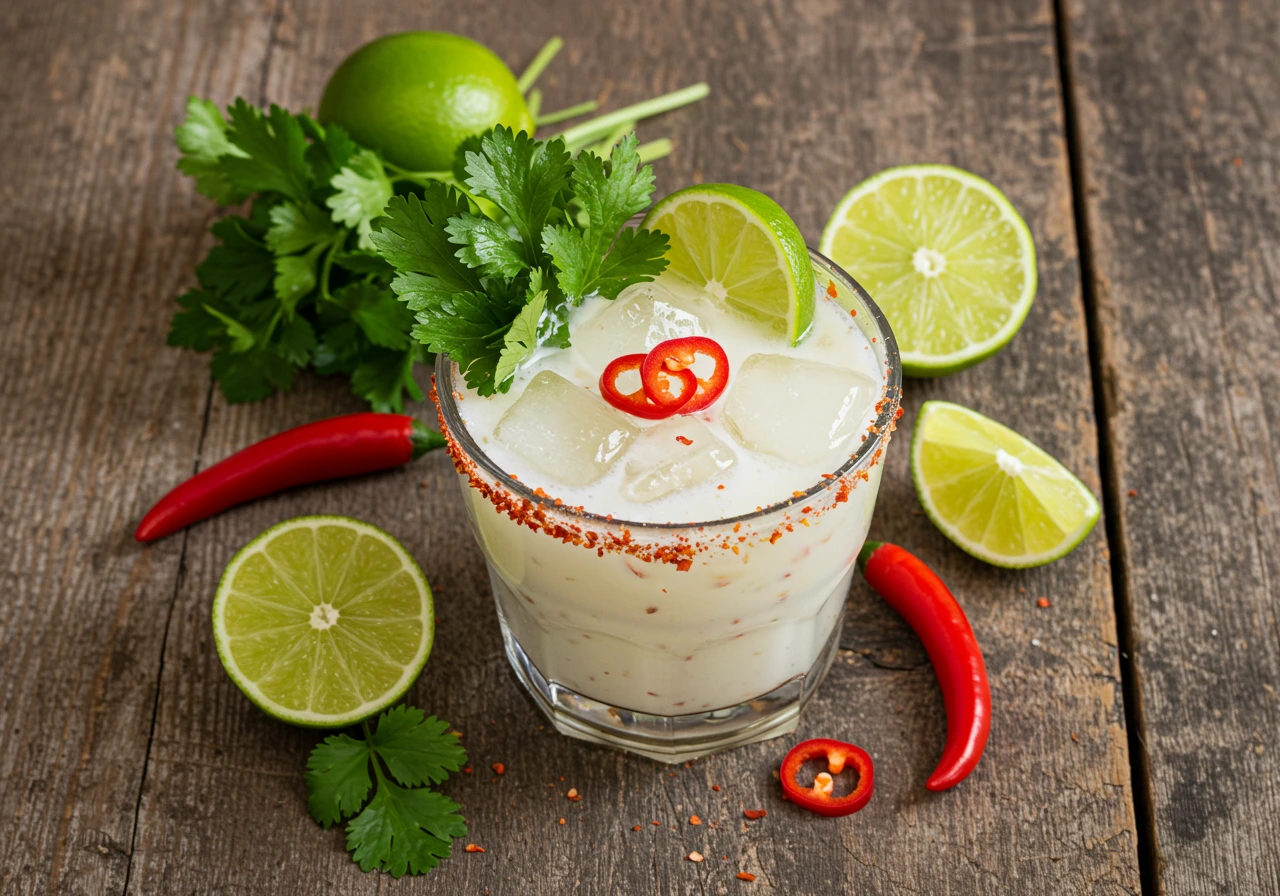Introduction to Leche de Tigre Recipe
Peruvian cuisine is full of vibrant flavors and unique culinary traditions, but few dishes capture the soul of the culture quite like Leche de Tigre. This zesty, citrus-based marinade is more than just a ceviche companion—it’s a bold, punchy elixir that stands on its own as a flavorful appetizer or even a revitalizing drink. Some even believe it has revitalizing properties, earning it a reputation as a hangover cure or energy booster.
But what exactly goes into making an authentic Leche de Tigre recipe? The beauty of this dish lies in its simplicity: fresh seafood, sharp acidity, and just the right amount of heat come together in a blend that’s as refreshing as it is complex. In this guide, we’ll explore everything—from selecting the best fish to perfecting the balance of flavors. Whether you’re making it as a marinade for ceviche or sipping it straight, get ready to bring a taste of Peru into your kitchen.
Part 1: Introduction to Leche de Tigre Recipe
What is Leche de Tigre Recipe?
At its core, Leche de Tigre (which translates to “Tiger’s Milk”) is a tangy, milky-white marinade made primarily of lime juice, fish stock, and seasonings. While it serves as the base for ceviche, in Peru, it’s often enjoyed as a standalone dish in a small glass, sometimes garnished with shrimp, cancha (toasted corn), or even a slice of sweet potato.
The name itself adds to the intrigue—some say it reflects the drink’s fierce, invigorating nature, while others believe it refers to its pale, cloudy appearance. Either way, Leche de Tigre remains an essential component of Peruvian seafood cuisine.
Origins and Cultural Significance
The origins of Leche de Tigre are deeply intertwined with Peruvian ceviche, which dates back thousands of years to the pre-Columbian era. Indigenous coastal civilizations were already marinating fish with the acidic juice of tumbo (a native fruit) long before the Spanish introduced citrus fruits.
As Peruvian cuisine evolved, Leche de Tigre became an essential part of the ceviche-making process and eventually took on a life of its own. Today, it is served in cevicherías across Peru, from Lima’s bustling food markets to high-end restaurants, and is even enjoyed as a revitalizing drink.
This dish isn’t just about flavor—it’s about history, tradition, and a way of life that celebrates the ocean’s bounty. For many Peruvians, a meal of ceviche isn’t complete without a shot of Leche de Tigre Recipe on the side.
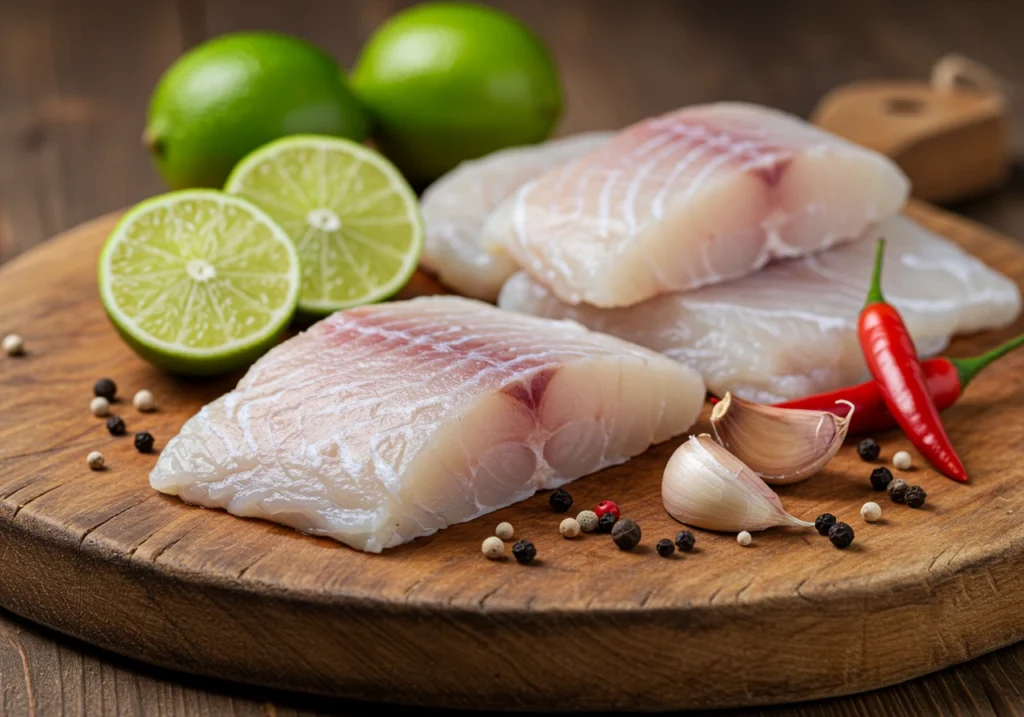
Essential Ingredients for an Authentic Leche de Tigre Recipe
The magic of Leche de Tigre comes from its carefully balanced ingredients. Here’s what you’ll need:
Primary Ingredients
- Fresh white fish (like sea bass or flounder) – The backbone of the dish, providing the base for the liquid and its unmistakable umami flavor.
- Fresh lime juice – The acidity that “cooks” the fish and brings out the vibrant flavors.
- Fish stock or broth – Adds depth and rounds out the flavor.
- Ají amarillo (Peruvian yellow chili) – A mildly spicy and slightly fruity pepper that gives the dish its signature kick.
- Garlic – Enhances the complexity of the marinade.
- Red onion – Adds sharpness and a touch of sweetness.
- Cilantro – For that fresh, herbaceous aroma.
- Celery – A surprising yet essential ingredient that adds freshness and balance.
- Salt and pepper – To season the mixture perfectly.
Optional Enhancements
- Ginger – A small touch can brighten the marinade.
- Shrimp or shellfish – For a richer variation.
- Evaporated milk – Some modern variations include it for a creamier consistency.
- Chopped rocoto pepper – If you prefer more heat.
The Role of Each Ingredient
Each component of Leche de Tigre plays a crucial role:
- The lime juice acts as a curing agent, giving the mixture its characteristic acidity.
- The fish stock provides umami depth.
- The ají amarillo adds a delicate heat without overpowering the dish.
- The cilantro and celery bring freshness, while the garlic and onions provide complexity.
Together, these ingredients create an umami-rich, tangy, and slightly spicy marinade that enhances any seafood it touches.
Personal Experience: The First Time I Tried Leche de Tigre Recipe
I’ll never forget the first time I tasted Leche de Tigre at a small ceviche shop in Lima. It came in a cold glass with a spoon, and it was an amazing mix of citrus, spice, and fresh seafood flavors. First, I noticed the sharp taste of lime and the kick of chili, then the rich seafood flavor came through. It was exciting, bold, refreshing, and unlike anything I’d tasted before. After that, I was hooked, and I knew I had to make it at home.
Now that we’ve covered the basics of what Leche de Tigre is and what goes into making it, let’s move on to the next essential step: choosing the perfect fish for an authentic and flavorful result.
Part 2: Preparing Leche de Tigre Recipe
Now that we’ve covered what Leche de Tigre is and the essential ingredients that create its bold, refreshing flavor, let’s dive into the preparation process. This step matters greatly because the quality of your ingredients—especially the fish—will determine whether you achieve an authentic Peruvian taste or produce something lackluster.
Let’s start with the most important component: the fish.
Selecting the Right Fish
Recommended Fish Varieties
Choosing the right fish is the foundation of a great Leche de Tigre Recipe. Since this dish is either served as a drink or as a marinade for ceviche, you’ll want fish that has a firm texture and mild, slightly sweet flavor. The best options include:
- Sea Bass (Corvina) – The traditional choice in Peru. Its delicate texture and mild sweetness blend beautifully with the citrus marinade.
- Flounder – A great alternative, offering a soft but sturdy texture that holds up well in the marinade.
- Snapper – Slightly firmer than sea bass, but still mild in taste and excellent for Leche de Tigre.
- Halibut – A meatier option that works well if you want a richer broth.
- Tilapia – A more accessible and budget-friendly alternative, though slightly less flavorful.
If you’re feeling adventurous, you can also use shellfish like shrimp or scallops for a unique twist.
Pro Tip: Avoid oily or strongly flavored fish like salmon or mackerel, as they can overpower the delicate citrus balance.
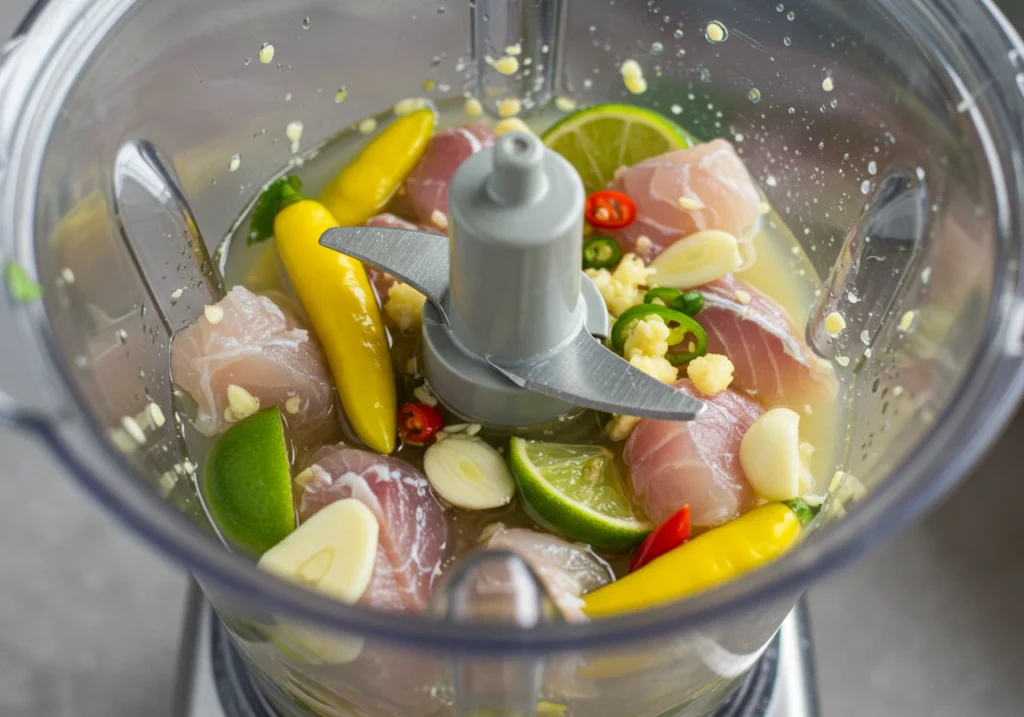
Importance of Freshness
When it comes to Leche de Tigre, freshness isn’t just important—it’s everything. Since the fish is lightly “cooked” in lime juice rather than heat, you need to start with the freshest fish possible to avoid any off flavors or potential food safety issues.
Here’s how to check for freshness:
- Smell: Fresh fish should have a clean, ocean-like scent—not a strong, fishy odor.
- Eyes: If buying whole fish, look for bright, clear, and slightly bulging eyes.
- Flesh: It should be firm and spring back when pressed, never mushy.
- Gills: If buying whole, they should be bright red, not brown or gray.
- Storage: Fish should always be stored on crushed ice and consumed within a day of purchasing.
If you can’t get ultra-fresh fish, opt for high-quality frozen fish labeled sushi-grade. This ensures it was frozen at a temperature that kills any potential parasites.
Step-by-Step Preparation Guide
Once you have your fresh ingredients ready, it’s time to turn them into Leche de Tigre! This process is surprisingly simple but requires attention to detail to get that perfect balance of tangy, spicy, and umami-rich flavors.
Ingredient Preparation
Before blending everything together, you need to prep the ingredients properly:
- Cut the fish – Dice your chosen white fish into small chunks (about 1-inch pieces). This helps extract more flavor when blending.
- Slice the onion – Thinly slice the red onion and soak it in ice water for 5 minutes. This removes bitterness and enhances the sweetness.
- Chop the ají amarillo – If using fresh ají amarillo, deseed and finely chop it. If using paste, have it measured out.
- Mince the garlic and ginger – These add complexity to the marinade.
- Prepare the celery – Chop a small stick of celery; this enhances freshness.
- Squeeze the limes – Freshly squeezed lime juice is a must! Avoid bottled juice, as it lacks brightness.
- Measure fish stock – A good Leche de Tigre includes fish stock to round out the flavors.
Having everything prepped and ready ensures a smooth blending process.
Blending Process
Now, the magic happens! Follow these steps to bring all the flavors together:
- Add the fish chunks to a blender along with the red onion, ají amarillo, garlic, ginger, and celery.
- Pour in the lime juice and fish stock, ensuring all the ingredients are submerged.
- Season with salt and pepper to taste.
- Blend on low speed for 30-45 seconds until the mixture is smooth and well-emulsified. Avoid over-blending, as too much heat can alter the flavor.
- Taste and adjust – If it’s too acidic, add a splash of fish stock. If it needs more heat, add extra ají amarillo.
You should now have a thick, creamy liquid with a balanced mix of acidity, spice, and umami.
Straining and Storage
After blending, you need to strain the mixture to achieve that silky smooth Leche de Tigre texture.
- Strain using a fine-mesh sieve over a bowl or pitcher.
- Press down gently on the solids with the back of a spoon to extract every bit of liquid.
- Taste one last time and adjust seasoning if needed.
Storage Tips
- Serve immediately for the freshest flavor.
- If storing, keep it in an airtight container in the refrigerator for up to 24 hours.
- Leche de Tigre is best consumed fresh, as the lime juice continues to break down the fish over time, altering the taste and texture.
Part 3: Serving and Enjoying Leche de Tigre Recipe
Now that you’ve mastered the art of preparing Leche de Tigre, it’s time to explore the best ways to enjoy this zesty, flavor-packed Peruvian classic. Whether you’re using it as a marinade for ceviche or sipping it straight as a revitalizing drink, serving Leche de Tigre correctly can elevate the entire experience. Plus, pairing it with the right sides and accompaniments ensures you get the most out of its bold, citrusy kick.
Let’s dive into the best serving methods and perfect pairings for this electrifying dish.
Traditional Serving Methods
As a Ceviche Marinade
The most common and arguably the best way to use Leche de Tigre is as the soul of ceviche. In Peru, ceviche isn’t just raw fish tossed in lime juice—it’s a symphony of flavors, textures, and colors, with Leche de Tigre acting as the binding element that brings everything together.
Here’s how to use Leche de Tigre for an authentic ceviche:
- Dice fresh fish (sea bass, flounder, or snapper) into bite-sized pieces.
- Marinate the fish in freshly made Leche de Tigre for 15-20 minutes—just long enough for the lime juice to “cook” the fish while preserving its delicate texture.
- Add thinly sliced red onions, chopped cilantro, and ají amarillo for extra freshness and spice.
- Garnish with sweet potato slices and cancha (toasted corn)—a traditional Peruvian touch.
- Serve chilled, ensuring the Leche de Tigre is abundant enough to be spooned alongside every bite.
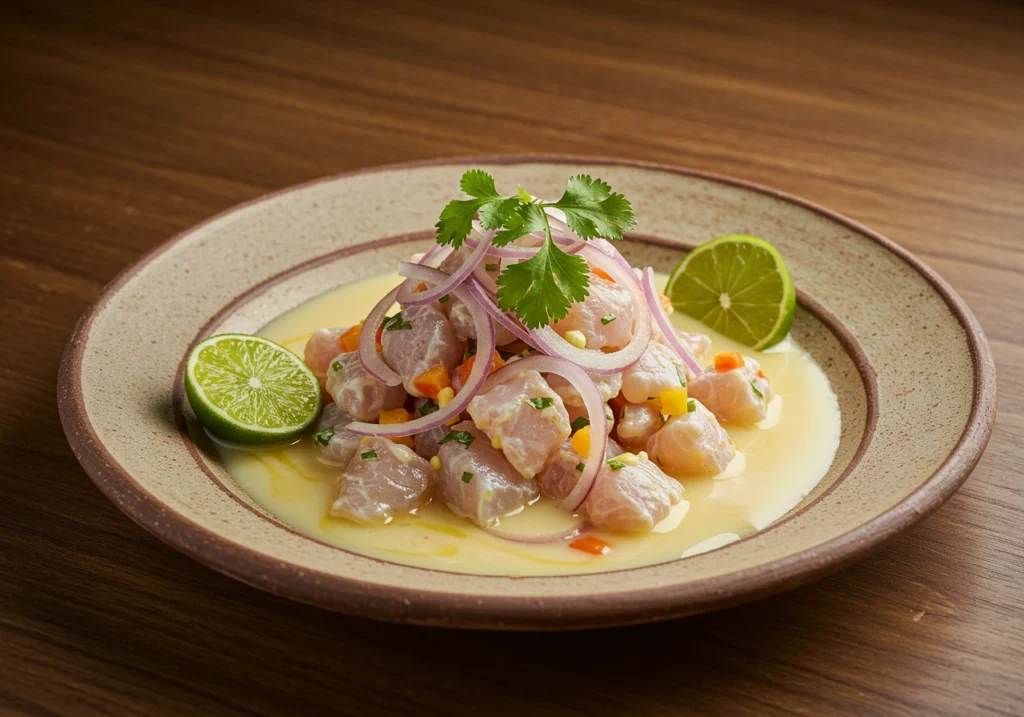
Pro Tip: If you love seafood variety, toss in shrimp, octopus, or scallops for a next-level ceviche experience.
As a Standalone Beverage
Beyond being a marinade, Leche de Tigre is also enjoyed as a bold, invigorating drink. Peruvians often serve it in small chilled glasses, treating it as both an appetizer and a supposed hangover cure.
To serve it as a drink:
- Chill the strained Leche de Tigre Recipe for at least 10 minutes before serving.
- Pour it into a shot glass or small tumbler.
- Garnish with a shrimp, cancha, and a slice of lime.
- Add extra ají amarillo or rocoto pepper if you love an extra spicy kick.
The result? A burst of citrus, spice, and umami, perfect for waking up the taste buds before a seafood feast. Some say it even has revitalizing properties, making it a great pick-me-up.
Accompaniments and Pairings
Common Side Dishes
Pairing Leche de Tigre with traditional Peruvian sides adds contrast in texture and flavor, making the dish even more delightful.
Here are the best side dishes to serve alongside:
- Cancha (Toasted Corn): These crunchy, nutty Peruvian corn kernels provide the perfect textural contrast to the smooth, citrusy Leche de Tigre.
- Chifles (Plantain Chips): The mild sweetness of crispy plantain chips balances out the acidity and heat.
- Sweet Potato Slices: A classic ceviche companion, sweet potato brings a natural sweetness that complements the tanginess of Leche de Tigre.
- Boiled Yuca (Cassava): This starchy root vegetable absorbs the marinade beautifully, adding a hearty element to the dish.
- Avocado Slices: Creamy avocado tones down the sharp acidity while enhancing the overall mouthfeel.
- Lettuce Leaves: Often used as a serving base, lettuce leaves provide a fresh, crisp contrast.
Pro Tip: If serving as a standalone drink, a small side of toasted corn and a lime wedge makes for the perfect pairing.
Beverage Pairings
Finding the right drink to accompany Leche de Tigre can enhance its flavors and create a more balanced experience.
Here are some ideal non-alcoholic beverage pairings:
- Chicha Morada: This sweet, spiced Peruvian drink made from purple corn, cinnamon, and cloves provides a lovely contrast to the acidity.
- Fresh Coconut Water: Its subtle sweetness and hydrating qualities make it a refreshing choice alongside the bold flavors.
- Sparkling Lime Water: The bubbles cleanse the palate, making every sip of Leche de Tigre feel fresh.
- Passion Fruit Juice: The tropical fruitiness complements the citrusy notes, creating a vibrant pairing.
Pro Tip: If serving Leche de Tigre as a ceviche marinade, opt for a light, refreshing beverage that won’t overpower the delicate seafood flavors.
Part 4: Variations and Culinary Innovations
Now that you’ve mastered the classic Leche de Tigre recipe, it’s time to explore the exciting world of regional and modern variations. This section will take you on a culinary journey through traditional coastal preparations, the influence of local ingredients, and innovative fusion recipes that bring a contemporary twist to this beloved Peruvian classic.
Regional Variations
Coastal vs. Inland Preparations
In coastal regions of Peru, Leche de Tigre is crafted to highlight the freshness of the abundant seafood. Here, the recipe typically features crisp, ocean-fresh fish like sea bass or snapper, which are marinated in a vibrant mix of lime juice, ají amarillo, and finely chopped red onions. The coastal method emphasizes the direct influence of the sea, ensuring every sip carries the unmistakable brininess and delicate sweetness of freshly caught fish. Inland preparations, on the other hand, rely on locally available produce and varied spice profiles. In regions where fresh fish is less accessible, chefs often incorporate alternative proteins or additional vegetables like tomato and bell pepper into Leche de Tigre. These inland versions may also feature local fruits, such as passion fruit, adding a subtle sweetness that balances the acidity.
Influence of Local Ingredients
Local ingredients profoundly shape the character of Leche de Tigre Recipe in various Peruvian regions. In coastal areas, the use of indigenous citrus varieties such as limón criollo lends a distinct, slightly bitter tang that enhances the overall flavor profile. Meanwhile, in the highlands, where produce is more robust, ingredients like rocoto or even native herbs are used to infuse an earthy warmth into the marinade. Moreover, some chefs experiment with local fish stocks enriched with regional spices, resulting in a thicker, more savory consistency. This creative approach not only celebrates the diversity of Peruvian agriculture but also underscores the importance of seasonality and locality in authentic cooking. As a result, each variation of Leche de Tigre tells a story—one of heritage, resourcefulness, and a deep connection to the land.
Modern Twists on Leche de Tigre
Fusion Recipes
Modern fusion recipes breathe new life into the traditional Leche de Tigre by combining it with culinary techniques and flavors from around the globe. Chefs now experiment by blending this Peruvian classic into dishes that incorporate elements from Asian, Latin American, and even Mediterranean cuisines. For instance, imagine infusing Leche de Tigre with a hint of miso or ginger, creating a vibrant cross-cultural ceviche that marries citrus acidity with umami depth. Other fusion approaches include adding avocado puree for creaminess or incorporating a dash of tamarind to further elevate the tang.
The result is a beautifully balanced dish that surprises the palate while honoring its roots. These innovative recipes invite diners to experience a familiar flavor in an entirely new context.
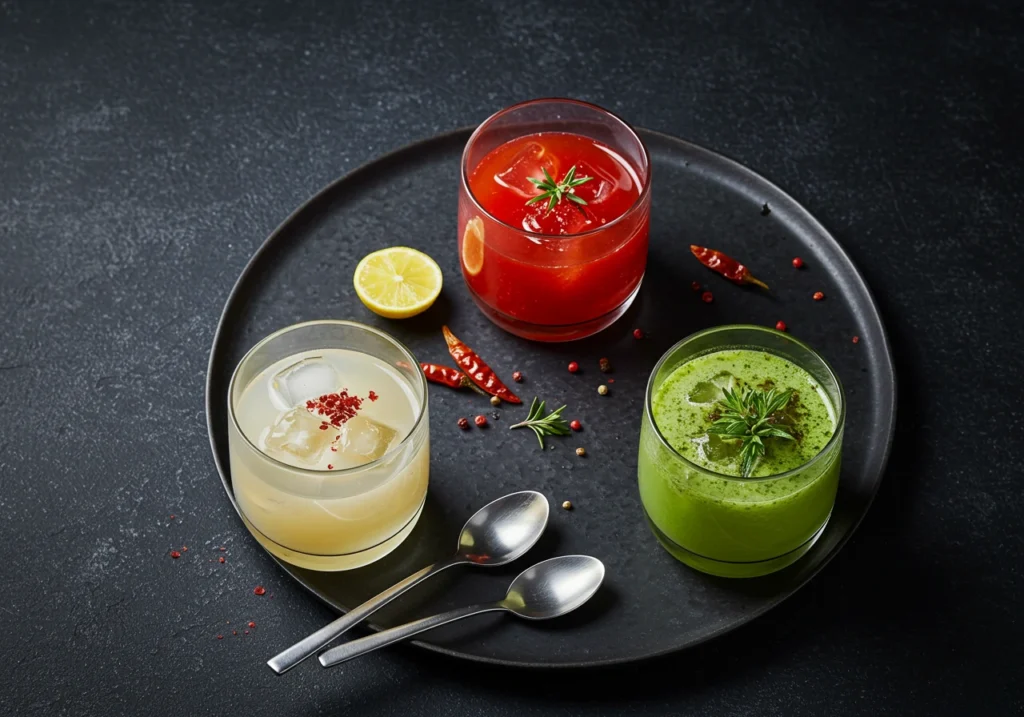
Incorporation in Contemporary Dishes
In the realm of contemporary cuisine, Leche de Tigre is increasingly finding its way into a variety of modern dishes. Beyond its classic role as a marinade for ceviche, this zesty elixir is now used as a flavorful dressing for salads, a drizzle over grilled seafood, and even as an ingredient in creative sauces. Chefs experiment by blending Leche de Tigre into vinaigrettes to add a unique citrusy kick or incorporating it into cold soups for a refreshing burst of flavor. Moreover, some innovative culinary professionals pair it with ingredients like quinoa, avocado, and microgreens to craft visually stunning and nutritionally balanced plates. This contemporary use not only honors the traditional flavors but also adapts them to the evolving tastes of today’s diners. By reimagining Leche de Tigre in such inventive ways, modern cuisine celebrates versatility and creativity, offering food enthusiasts new ways to enjoy a beloved Peruvian staple.
Part 6: Frequently Asked Questions
Over the years, Leche de Tigre has gained worldwide recognition, and naturally, people have started asking many questions about this bold, zesty Peruvian dish. Whether you’re new to Leche de Tigre or simply want to deepen your knowledge, these frequently asked questions will help you understand its ingredients, history, and how it differs from similar dishes.
What is Leche de Tigre made of?
Leche de Tigre is a zesty citrus-based marinade used in Peruvian cuisine, primarily as a base for ceviche. The key ingredients include fresh lime juice, fish stock, ají amarillo (Peruvian yellow chili), garlic, red onion, cilantro, celery, and salt. White fish, such as sea bass or flounder, is typically blended into the mixture to give it a creamy consistency. The result is a flavorful, umami-rich liquid with a balance of acidity, spice, and freshness. While the classic recipe remains popular, variations include shrimp, scallops, and other shellfish, along with regional substitutions like camu camu (Amazonian citrus) or evaporated milk for a richer texture.
What is Tiger Milk made of?
“Tiger Milk” is simply the English translation of Leche de Tigre, and it refers to the same tangy, citrusy seafood marinade. The main components of Tiger Milk include fresh lime juice, fish broth, blended fish, ají amarillo, garlic, red onion, and cilantro. In some variations, evaporated milk, rocoto chili, or shellfish may be included to enhance the complexity of flavors. While traditionally used as a ceviche marinade, it is also enjoyed as a revitalizing drink. Some believe it has invigorating properties, making it a popular choice for a quick energy boost or even a hangover remedy.
What’s the difference between Leche de Tigre and Ceviche?
Although Leche de Tigre and ceviche are closely related, they are not the same dish.
- Leche de Tigre is the citrusy, spicy marinade used to “cook” raw fish in ceviche. It is a liquid blend of lime juice, fish broth, seasonings, and sometimes blended fish to create a creamy, umami-packed base.
- Ceviche, on the other hand, is a dish that consists of raw seafood marinated in Leche de Tigre, often mixed with red onions, ají amarillo, and cilantro.
- While Leche de Tigre is the backbone of ceviche, it is also consumed on its own as a flavorful appetizer, typically served in a small glass with garnishes like shrimp or toasted corn.
Why is it called Tiger’s Milk?
The name Leche de Tigre (“Tiger’s Milk”) is believed to have several origins, but the most common explanations include:
- Its invigorating nature – Peruvians often claim that drinking Leche de Tigre gives you strength and energy, much like a tiger’s ferocity.
- Its milky appearance – When blended, the lime juice emulsifies with the fish proteins, creating a milky-white color, resembling actual milk.
- Culinary folklore – Some say that Leche de Tigre has aphrodisiac properties, making it a legendary “power drink” in Peruvian cuisine.
Regardless of the name’s origin, one thing is certain: Leche de Tigre packs a bold punch of flavor that leaves a lasting impression.
Part 7: Conclusion
Recap of Key Points
Throughout this guide, we’ve explored the rich history, bold flavors, and versatile uses of Leche de Tigre, a cornerstone of Peruvian seafood cuisine. From its essential ingredients like fresh fish, lime juice, ají amarillo, and fish broth to the step-by-step preparation process, we’ve covered everything you need to craft an authentic, flavor-packed version of this dish at home.
We also delved into regional variations, exploring how coastal and inland adaptations bring unique twists to this classic recipe. Plus, we looked at modern culinary innovations, including fusion dishes that take Leche de Tigre beyond ceviche. Whether you use it as a ceviche marinade or enjoy it as a revitalizing drink, it’s clear that this dish offers endless possibilities.
With the right pairings, serving techniques, and ingredient choices, you can customize Leche de Tigre to suit your taste and creativity.
Encouragement to Experiment and Enjoy
Now that you’ve mastered the fundamentals, you can start experimenting! Explore different fish varieties, adjust the spice levels, and pair it with various sides to craft your own signature Leche de Tigre. Get creative—add tropical fruits, infuse it with herbs, or incorporate it into unexpected dishes.
Most importantly, share this vibrant dish with family and friends. Leche de Tigre is more than just a recipe—it’s a celebration of fresh flavors, cultural tradition, and culinary adventure. So, gather your ingredients, blend up a batch, and enjoy the bold, zesty magic of Peru’s Tiger’s Milk! 🐯🍋🐟

